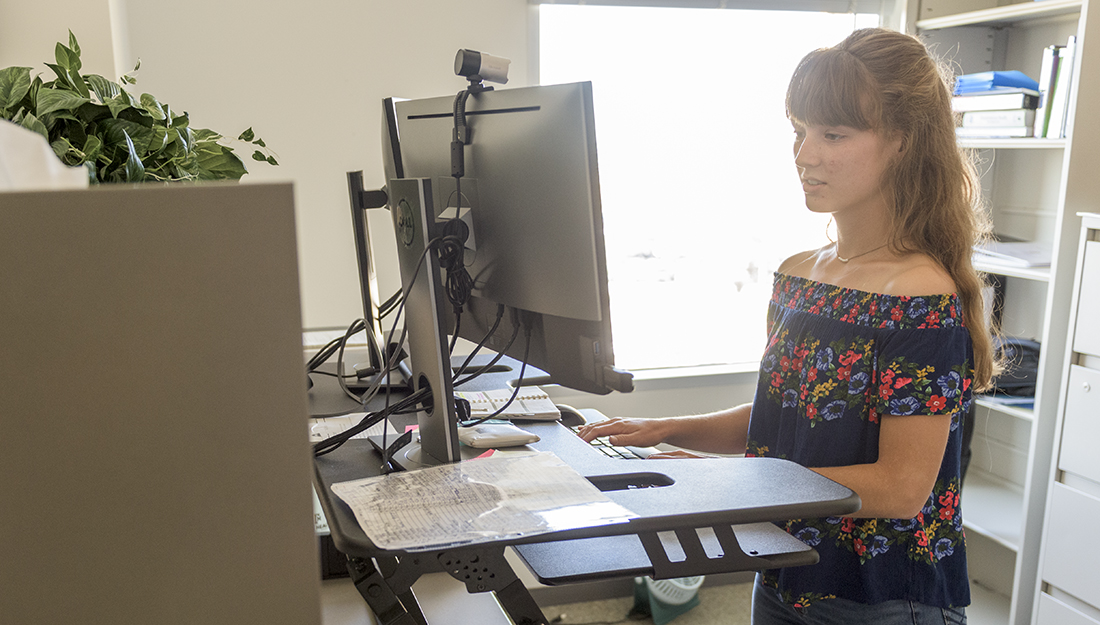- Mary Leigh Meyer
- Public Health, Research, Show on VR homepage
A technological answer to sedentary lifestyles
Software found to be effective in increasing the time an office worker stands and changes position

Sedentary lifestyles_A woman in using a sit-stand desk in her office on the Texas A&M campus
In the age of technology, an average workday for many people involves extended periods of staying sedentary. Whether sitting at a desk or in a meeting, episodes of prolonged sitting can be dangerous to workers’ health. Inactive or sedentary lifestyles can increase the risk of developing heart disease, high blood pressure, type 2 diabetes. Similarly, if people are not getting enough regular exercise, the risk of feelings of depression and anxiety rises, as does the risk for colon, breast and uterine cancers.
“Sedentary lifestyles are one of the biggest health risks to this generation,” said Mark Benden, PhD, CPE, department head and director of the Ergonomics Center at the Texas A&M School of Public Health. “If we can find ways to get office workers to stand up and move more throughout the day, then those little movements will do a lot to help their overall health.”
What is a sit-stand desk?
A sit-stand desk is a height-adjustable platform placed on top of the desk itself. The desk users are required to lift or lower the platform to change to sitting and standing heights.
“These types of desks provide the office worker more ergonomic support,” Benden said. “The act of moving back and forth between sitting and standing uses more energy than either sitting or standing alone.” He says it is crucial for people to routinely change positions and hopefully pick up extra steps in the process as core strength increases and ambulation occurs more frequently.
Sit-stand desks have become an international trend. However, utilization rates are still below expectations. Therefore, they are unlikely, at typical use levels, to produce the type of health impacts researchers like Benden had hoped to achieve.
Studying how technology can prevent workplace inactivity
A research team led by Benden and Parag Sharma, DrPH, a recent doctoral graduate of the School of Public Health and clinical data scientist at Humana, tested a new computer-based software intervention. The software aimed to increase the number of position changes in a group of workers within the Division of Student Affairs on the Texas A&M University campus. The study, published in the International Journal of Environmental Research and Public Health, evaluated the use of computer-prompted reminders to determine if the frequency of desk position changed.
To start the study, researchers installed the software, which was designed to use reminders to change the position of their sit-stand desks and monitor workers’ computer use time, and a USB accelerometer sensor, which measured the height of the desk.
The first phase of the study only monitored workers’ computer use time and the position of the desk. This phase lasted three months and provided a baseline of the activity of the participants. The second phase of the study lasted two months and utilized the software to remind the participants to stand for 10 minutes after every 30 minutes of sitting. Also, the software displayed statistics about percentage of time they personally stood and remained seated.
This study was the very first to measure digital, objective data about desktop, sit-stand desk usage and it offered potentially noteworthy findings and methods.
The importance of the results
After collecting the data, researchers found the software proved effective in getting office workers to stand more often than they did before the software reminders. During the first phase, the participants completed one desk position change per every two working days. However, during the second phase, they, on average, completed one desk position change every day.
“The people who needed to sit and stand the most, as in the people who tended to remain the most sedentary throughout the day, responded the most to this software,” Benden said. “A group of participants did not use the sit-stand desk at all during the first phase. However, with the software reminders, not a single person failed to use their sit-stand desk.”
After the second phase, the researchers gave the participants a survey. The results of the survey indicated 51 percent of the workers were influenced and more motivated by observing their co-workers’ habits with the sit-stand desks rather than by the software reminders. The social context for reducing sedentary behavior is an important finding for future studies.
The significance of the results
“Texas A&M is a living learning laboratory, and we have thousands of office workers here on campus who may benefit from this work,” Benden said. “We are thrilled Texas A&M invests in the health of their workers and they support our efforts to develop methods to increase their health.”
Media contact: media@tamu.edu


